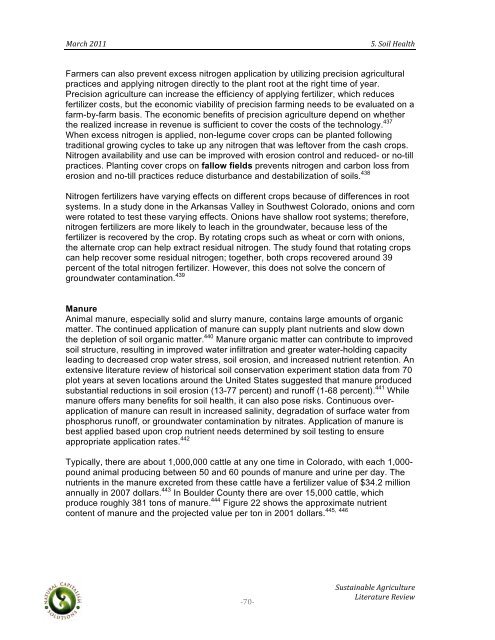Sustainable Agriculture Literature Review - Boulder County
Sustainable Agriculture Literature Review - Boulder County
Sustainable Agriculture Literature Review - Boulder County
You also want an ePaper? Increase the reach of your titles
YUMPU automatically turns print PDFs into web optimized ePapers that Google loves.
! !!<br />
"#$%&!'())!! !!!!!!!!!!!!!!!!!!!!!!!!!!!!!!!!!!!!!!!!!!!!!!!!!!!!!!!!!!!!!!!!!!!!!!!!!*+!,-./!01#/2&!<br />
Farmers can also prevent excess nitrogen application by utilizing precision agricultural<br />
practices and applying nitrogen directly to the plant root at the right time of year.<br />
Precision agriculture can increase the efficiency of applying fertilizer, which reduces<br />
fertilizer costs, but the economic viability of precision farming needs to be evaluated on a<br />
farm-by-farm basis. The economic benefits of precision agriculture depend on whether<br />
the realized increase in revenue is sufficient to cover the costs of the technology. 437<br />
When excess nitrogen is applied, non-legume cover crops can be planted following<br />
traditional growing cycles to take up any nitrogen that was leftover from the cash crops.<br />
Nitrogen availability and use can be improved with erosion control and reduced- or no-till<br />
practices. Planting cover crops on fallow fields prevents nitrogen and carbon loss from<br />
erosion and no-till practices reduce disturbance and destabilization of soils. 438<br />
Nitrogen fertilizers have varying effects on different crops because of differences in root<br />
systems. In a study done in the Arkansas Valley in Southwest Colorado, onions and corn<br />
were rotated to test these varying effects. Onions have shallow root systems; therefore,<br />
nitrogen fertilizers are more likely to leach in the groundwater, because less of the<br />
fertilizer is recovered by the crop. By rotating crops such as wheat or corn with onions,<br />
the alternate crop can help extract residual nitrogen. The study found that rotating crops<br />
can help recover some residual nitrogen; together, both crops recovered around 39<br />
percent of the total nitrogen fertilizer. However, this does not solve the concern of<br />
groundwater contamination. 439<br />
Manure<br />
Animal manure, especially solid and slurry manure, contains large amounts of organic<br />
matter. The continued application of manure can supply plant nutrients and slow down<br />
the depletion of soil organic matter. 440 Manure organic matter can contribute to improved<br />
soil structure, resulting in improved water infiltration and greater water-holding capacity<br />
leading to decreased crop water stress, soil erosion, and increased nutrient retention. An<br />
extensive literature review of historical soil conservation experiment station data from 70<br />
plot years at seven locations around the United States suggested that manure produced<br />
substantial reductions in soil erosion (13-77 percent) and runoff (1-68 percent). 441 While<br />
manure offers many benefits for soil health, it can also pose risks. Continuous overapplication<br />
of manure can result in increased salinity, degradation of surface water from<br />
phosphorus runoff, or groundwater contamination by nitrates. Application of manure is<br />
best applied based upon crop nutrient needs determined by soil testing to ensure<br />
appropriate application rates. 442<br />
Typically, there are about 1,000,000 cattle at any one time in Colorado, with each 1,000pound<br />
animal producing between 50 and 60 pounds of manure and urine per day. The<br />
nutrients in the manure excreted from these cattle have a fertilizer value of $34.2 million<br />
annually in 2007 dollars. 443 In <strong>Boulder</strong> <strong>County</strong> there are over 15,000 cattle, which<br />
produce roughly 381 tons of manure. 444 Figure 22 shows the approximate nutrient<br />
445, 446<br />
content of manure and the projected value per ton in 2001 dollars.<br />
!<br />
"+&"<br />
!,342#.5#6/1!78$.%3/23$1!<br />
9.21$#23$1!:1;.1
















